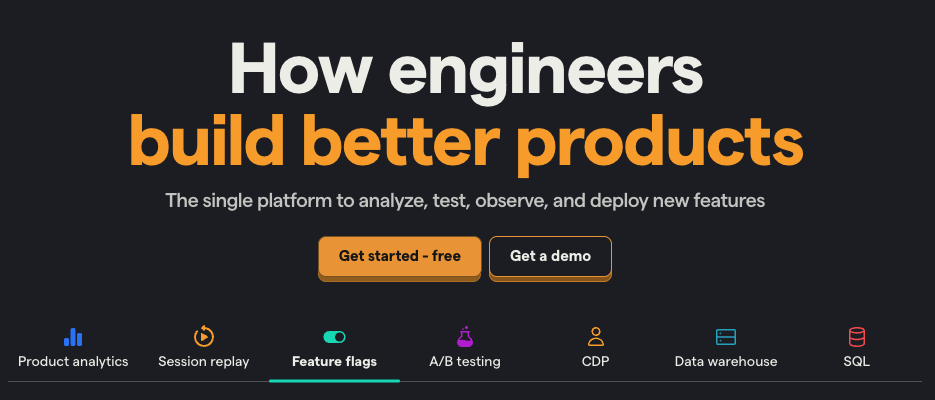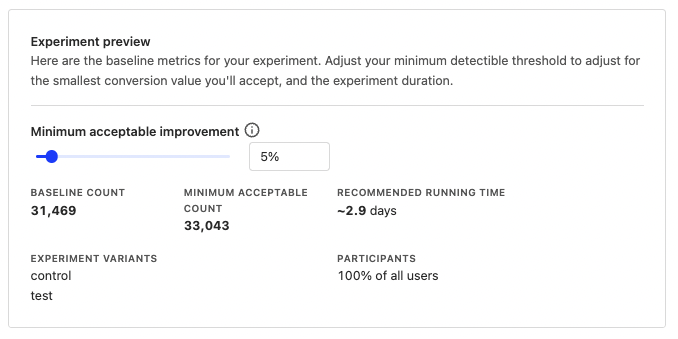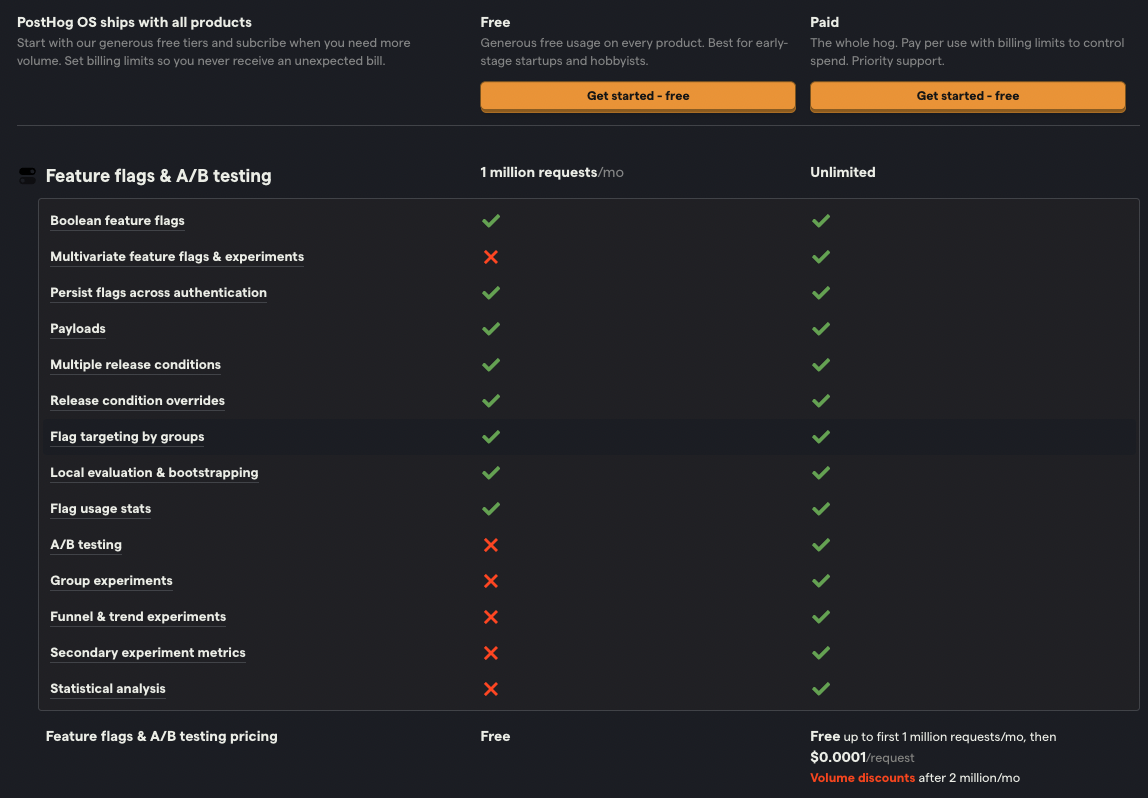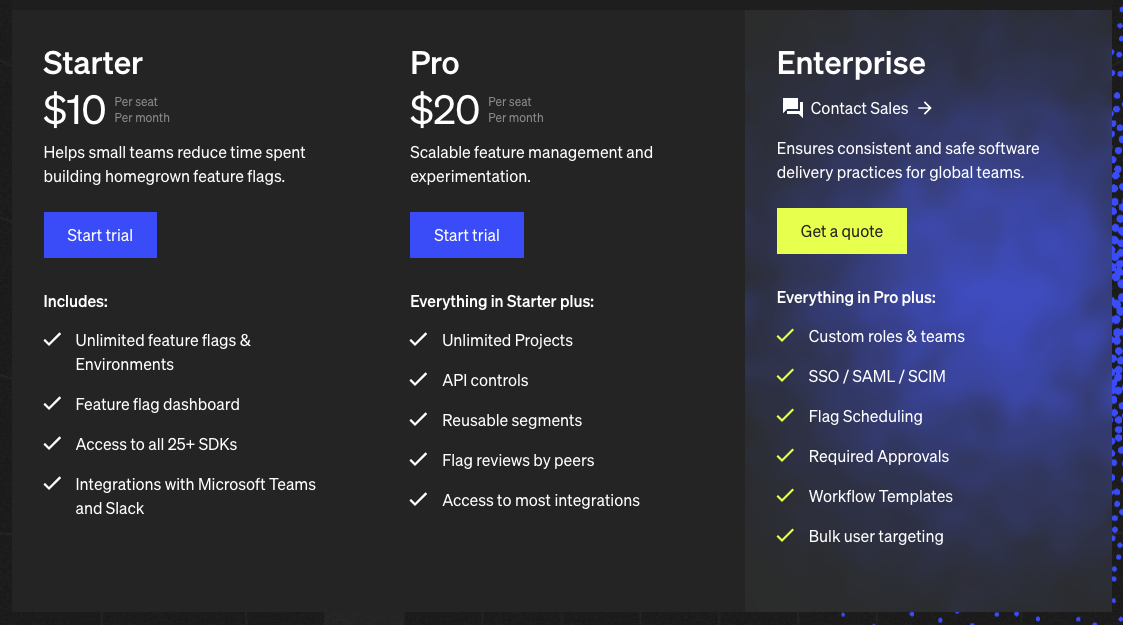In-depth: PostHog vs LaunchDarkly
Oct 03, 2023

On this page
- How is PostHog different?
- 1. It is an all-in-one platform
- 2. We’re transparent (in many ways)
- 3. Built for startups and engineers
- Comparing PostHog and LaunchDarkly
- Platform
- Feature management
- Experimentation
- Pricing
- Reporting and analytics
- Integrations
- Security and compliance
- Frequently asked questions
- Who is PostHog useful for?
- Who is LaunchDarkly useful for?
- How much does PostHog cost?
- How much does LaunchDarkly cost?
- Does LaunchDarkly or PostHog offer free trials?
- How long does it take to implement PostHog?
- How long does it take to implement LaunchDarkly?
PostHog and LaunchDarkly both offer feature flagging and A/B testing, which allow you de-risk releases, increase engineering velocity, configure your app remotely, customize experiences, and more.
But how are they different? If you remember nothing else, remember these two points:
LaunchDarkly only does feature flags and experiments.
PostHog is an all-in-one platform that does flags, experiments and a whole bunch more, including analytics, session replays, and user surveys.
In this post, we'll cover these differences in more detail, comparing features, pricing, reporting, integrations, and frequently asked questions about both.
How is PostHog different?
1. It is an all-in-one platform
PostHog includes all the tools product teams need to test, release, and measure the success of new features. Beyond the feature flag and A/B testing tools, this includes product analytics, session replays, surveys, and more.

These tools add an extra layer of analysis unavailable in LaunchDarkly. They enable you to make better decisions about features you’ve shipped and what you’re building next. They also enable you to combine data from multiple tools, such as user properties from analytics, for use in flags and experiments.
2. We’re transparent (in many ways)
PostHog is open source. Our code, culture, and strategy are public on GitHub and our handbook. While LaunchDarkly open sourced some code (like SDKs), most is closed source.
We're also self-serve. No need to "talk to sales" or "schedule a demo" unless you want to – we're always happy to chat. You can sign up and try all the features PostHog offers for free.
Our pricing is also transparent. It is a two-tier usage-based model, which we make easy to predict. This is simpler than LaunchDarkly’s multi-tier combination of charging for seats, monthly context instances, and add-ons. If you worry about overages, you can set up billing limits in PostHog too.
3. Built for startups and engineers
PostHog is built for high-growth startups. This means it's simple for engineers to implement themselves. We have many SDKs, tutorials, and docs to help you get started quickly with any type of app.
After setting up, PostHog aligns with startups as they scale up, providing tools like advanced product analytics, CDPs, and data warehousing to combine the tools they need into one.
LaunchDarkly focuses on enterprise users, managers, and DevOps. This means more focus on governance and integrations.
Comparing PostHog and LaunchDarkly
Platform
Both PostHog and LaunchDarkly built the infrastructure to use flags and experiments fast and effectively with your current app. PostHog does this more openly, both being open source and self-service. It also has a wider range of product and data tools built in.
| PostHog | LaunchDarkly | |
Open source Code publicly accessible | ✔ | Partial |
Self-service No need to talk to sales | ✔ | ✖ |
All major SDKs JavaScript, Android, iOS, Python, and more | ✔ | ✔ |
Proxies Reverse proxy to avoid blockers | ✔ | ✔ |
API Edit and evaluate flags with API | ✔ | Pro |
Local evaluation Faster flags by not having to rely on the server for evaluation | ✔ | ✔ |
Bootstrapping Flags available on frontend application load | ✔ | ✔ |
SQL Query flag and product data directly via SQL | ✔ | ✖ |
Session replays Real user playback of flag session | ✔ | ✖ |
Feature management
Both PostHog and LaunchDarkly offer all the functionality you expect for feature management using feature flags.
| PostHog | LaunchDarkly | |
Boolean flags Simple flags returning true or flag | ✔ | ✔ |
Percentage rollouts Target percentages of a group | ✔ | ✔ |
Custom targeting Target users based on user properties, custom contexts | ✔ | ✔ |
Multivariate flags Flags with multiple customizable values | ✔ | ✔ |
JSON payloads Flags return JSON | ✔ | ✔ |
Environments Manage flags for dev, stage, prod | Partial | ✔ |
Scheduling Schedule flags to turn on or off | ✔ | Enterprise |
Workflows Manage changes to flags | ✖ | ✖ |
Lifecycle management Display new and old flags | ✖ | ✔ |
Triggers Trigger changes based on metrics | ✖ | ✔ |
Unlimited targeting size Target contexts of any size | ✔ | Enterprise |
Early access management Manage betas, test features | ✔ | ✖ |
LaunchDarkly’s enterprise plan unlocks advanced workflow features like scheduling, lifecycle management, triggers, and more. PostHog’s API enables you to mimic this functionality if needed, but it isn’t built into the UI.
Experimentation
PostHog and LaunchDarkly have relatively similar experimentation feature sets, enabling you to run A/B/n tests with custom goals and calculate if they have a statistically significant impact.
| PostHog | LaunchDarkly | |
Free usage How many experiments can you run for free? | 1M requests per month | None, paid add-on |
Custom goals Customize metrics that test tracks | ✔ | ✔ |
Secondary metrics Monitor impact on unrelated metrics | ✔ | ✔ |
Statistical significance calculation Calculate if changes make a statistically significant impact | ✔ | ✔ |
Split testing Split participants into groups | ✔ | ✔ |
Multivariate (A/B/n) testing Test multiple variants of a change | ✔ | ✔ |
Recommended run time Calculate the recommended run time for your experiments | ✔ | ✖ |
PostHog automatically calculates a recommended run time based on past data and minimally acceptable improvements. This helps you avoid the peeking problem and end your experiment at the right time.

Pricing
PostHog and LaunchDarkly are priced significantly different.
| PostHog | LaunchDarkly | |
Pricing | Per-request pricing | Based on MAU + seats + add-ons |
Free plan | ✔ | Trial only |
Free experiments | ✔ | ✖ |
Free collaboration | ✔ | ✖ |
PostHog’s feature flag pricing is pay-per-request (and A/B tests use feature flags). There is a generous free tier of 1M requests per month with all features, add-ons, and integrations available.

LaunchDarkly’s pricing is more complicated. They charge by seat starting at $10/seat/month. On top of this, they charge based on "monthly context instances" (MCIs) also known as monthly active users. The pro plan only gets 1,000 frontend MCIs per month. You must upgrade to the $20/seat/month to more than 1,000 MCIs, then pay more beyond 10,000.

As mentioned earlier, many of the security, approval, and workflow features that differentiate them are only available at the opaque "Enterprise" level.
Example scenarios
To give you an idea of what pricing looks like in reality, here are some example situations and their estimated costs for both PostHog and LaunchDarkly.
| Seats | MAUs | Requests | Request location | PostHog cost | LaunchDarkly cost |
| 5 | 5,000 | 1,000,000 | Backend | $0 | $100 |
| 10 | 15,000 | 1,000,000 | Frontend | $0 | $200 + cost of 5000 MAUs |
| 20 | 25,000 | 5,000,000 | Backend | $400 | $400 |
| 30 | 50,000 | 15,000,000 | Frontend | $1,400 | ??? (Enterprise) |
Notes:
- Using backend local evaluation in PostHog lowers the amount of flag usage to depend on the polling duration and active number of servers. If you use flags with one server polling every 30 seconds, this amount is under 1M requests (meaning free).
- PostHog has volume discounts on flags over 2 million requests per month.
Reporting and analytics
Although LaunchDarkly has basic reporting features, PostHog has a more expansive analytics suite. Visualizations, funnels, retention, SQL querying, and session replays are all integrated with flags and A/B testing data. This enables you to do deeper analysis of their impact and combine them with other product and usage data.
| PostHog | LaunchDarkly | |
Analytics Capture usage and calls related to flags | ✔ | ✔ |
Trends Graphs of flag usage | ✔ | ✔ |
Funnel visualization Analyze impact of flags on funnels | ✔ | ✖ |
Retention User retention related to flags | ✔ | ✖ |
Breakdowns Breakdown analytics by properties | ✔ | ✖ |
Dashboards Multiple customizable insights for a flag | ✔ | ✖ |
Non-flag data Combine flag data with other product data | ✔ | ✖ |
Integrations
Both PostHog and LaunchDarkly have a range of integrations that enable them to import, export, enhance, and make use of data.
| PostHog | LaunchDarkly | |
Free integrations Use integrations on the free plan | ✔ | ✖ |
Exports Export data to other sources | ✔ | Enterprise |
Imports Import data from source | ✔ | ✔ |
Slack Alerts for Slack | ✔ | ✔ |
Microsoft Teams Alerts for Microsoft Teams | ✔ | ✔ |
Zapier Trigger Zapier automations | ✔ | ✔ |
Sentry Connect to Sentry data | Two-way | One-way |
Edge tools Use edge networks | ✖ | ✔ |
LaunchDarkly has more pre-built integrations, but some are only available on higher paid plans, and others replicate functionality built-in to PostHog as standard. These include environments as a service, observability tools, workflow management, and more.
PostHog’s event-based structure enables you to import data from anywhere for use with flags and experiments. The free API enables you to connect, edit, and capture from anywhere too.
PostHog’s data warehouse is in private beta and will soon make outside data available for use in PostHog.
Security and compliance
Both PostHog and LaunchDarkly enable companies to remain secure and compliant with privacy regulations. Companies can customize the levels of user privacy related to these platforms to their needs.
| PostHog | LaunchDarkly | |
User privacy options Anonymize users, drop personal data | ✔ | ✔ |
History, audit logs Manage and view flag edits and related users | ✔ | ✔ |
GDPR-ready Can be compliant with GDPR | ✔ | Pro |
SOC 2 SOC 2 security certification | ✔ | ✔ |
2FA Enforce login with two-factor authentication | ✔ | ✔ |
SAML/SSO Use SAML or single sign-on authentication | Enterprise | $10/seat/month or Enterprise |
Approvals Require approvals to change flags | ✔ | Enterprise |
Permissioning Control who can edit and modify flags | ✔ | Enterprise |
Many of LaunchDarkly’s advanced compliance tools are only available on their enterprise plans. PostHog also features SSO and SAML in its enterprise edition.
Frequently asked questions
Who is PostHog useful for?
PostHog is built for startups and their engineers. It provides all the tools startups need to build successful products. The people who find PostHog most useful are founders, product engineers, and growth engineers.
Companies that use PostHog feature flags and experiments include Y Combinator, Vendasta, and AssemblyAI.
Who is LaunchDarkly useful for?
LaunchDarkly is built for enterprises wanting to follow software development best practices. This means managing features, de-risking releases, experimenting with changes, and coordinating deploys. The people who find LaunchDarkly most useful are engineering managers, site reliability engineers, and product managers.
Companies that use LaunchDarkly include IBM, Atlassian, Bayer, and HP.
How much does PostHog cost?
Feature flags and experiments are free for up to 1M requests per month. Beyond that, it costs $0.0001/request (or $1 per 10,000 requests). There are discounts for high-volume users, non-profits, and startups.
Other products, like product analytics and session replay, have separate but similarly structured pricing.
How much does LaunchDarkly cost?
LaunchDarkly starts at $10 per seat per month. This includes unlimited flags, server-side monthly active users, and 1,000 client-side monthly active users. More client-side monthly active users, also known as monthly context instances, cost more.
Their pro plan doubles the cost to $20 per seat per month. It adds API, unlimited projects, and more integrations. Above that, their enterprise plan requires talking to sales. It includes custom roles, SSO, scheduling, workflows, and more.
Does LaunchDarkly or PostHog offer free trials?
LaunchDarkly offers a 14-day free trial, but beyond that, all access and features are paid.
PostHog lets you use all its features for free. Once you upgrade to paid, you get 1M flag requests, 1M events, and 15,000 recordings for free each month. This means if you stay below this, PostHog remains free.
How long does it take to implement PostHog?
Feature flags and experiments are simple. They are a few lines of code in all of your favorite languages. They can even be set up on no-code site builders like Framer or Webflow.
The process requires signing up for PostHog, installing the snippet or SDK in your app, creating the flag in PostHog, and implementing the flag evaluation and relevant logic in your app. In many of the SDKs, we handle important aspects like local evaluation and event capture for you.
Much of the PostHog implementation, like user identification, is reused across products. Because PostHog is an all-in-one platform, analytics capture for targeting and A/B testing doesn’t need set up or connection either.
How long does it take to implement LaunchDarkly?
Installing LaunchDarkly is relatively simple, depending on your needs and compliance requirements. The most basic form is starting your LaunchDarkly trial, installing their SDK, setting up a client or provider, identifying users or contexts, calling flags, and capturing events.
The differences with PostHog are needing to import user context data, set up context identification, capture the flag or A/B test usage, and import analytics into the platform.
Ready to find out more?
